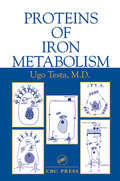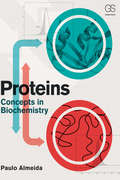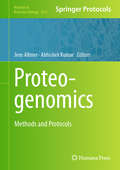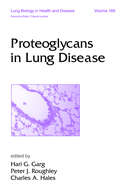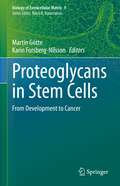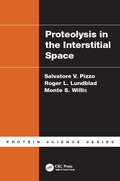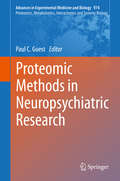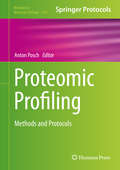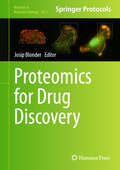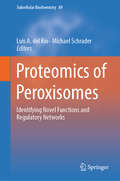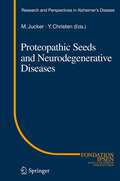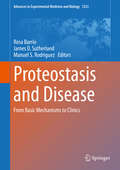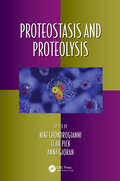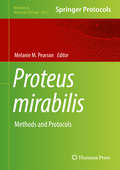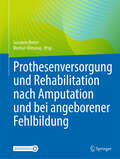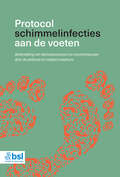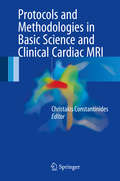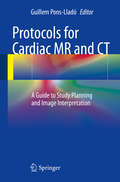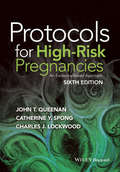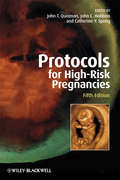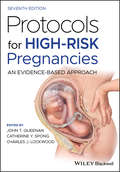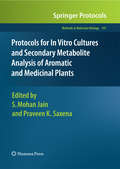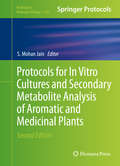- Table View
- List View
Proteins of Iron Metabolism
by Ugo TestaProteins of Iron Metabolism presents a clear picture of the structure and function of the main proteins involved in iron metabolism. The book gives you a detailed description of the structure and function of each protein, and discusses the structure and regulation of the corresponding genes in parallel. It supplies an analysis of the differential e
Proteins of the Nucleolus
by Andrew Catalano Danton H O'DayThis book contains 14 original review chapters each yielding new, exciting and intriguing data about the emerging understanding of nucleolar structure and function in normal, stressed and diseased cells. The goal of this work is to provide special insight into the nucleolus of the past, present and future, as well its regulation, translocation, and biomedical function. A multitude of topics are introduced and discussed in detail, including nucleologenesis, nucleolar architecture, nucleolar targeting, retention, anchoring, translocation, and the relationship between the nucleolus and cancer. This book also brings together work from several different species, from human to Drosophila to Dictyostelium and other eukaryotic microbes. The final chapter summarizes some of the issues brought up in the various chapters with a view to future research. This book supports the continued emergence of the nucleolus as a dynamic intranuclear region that oversees a vast diversity of events.
Proteins: Concepts in Biochemistry
by Paulo AlmeidaProteins: Concepts in Biochemistry teaches the biochemical concepts underlying protein structure, evolution, stability and folding, and explains how interactions with macromolecular structures determine protein function. Intended for a one-semester biochemistry course with a focus on proteins, this textbook emphasizes the logic underlying biophysical chemical principles. Problems throughout the book encourage statistical and quantitative thinking. The text is ideal for senior undergraduates, first year graduate students, and practitioners in chemistry, biochemistry, biology, and biophysics.
Proteogenomics: Methods and Protocols (Methods in Molecular Biology #2859)
by Jens Allmer Abhishek KumarThis volume presents an up-to-date overview of the current state-of-the-art protocols, and aims to put proteogenomics into a broader perspective. The chapters in this book detail methods and techniques ranging from mass spectrometry to proteomics and proteogenomics and their biomedical implications and applications. Written in the highly successful Methods in Molecular Biology series format, the chapters include introductions to their respective topics, application details for both the expert and non-expert reader, and tips on troubleshooting and avoiding known pitfalls. A highlight for everyone new to the field are the chapters, which put proteogenomics to use to answer biomedical questions. Authoritative and accessible, Proteogenomics: Methods and Protocols aims to ensure successful results in the further study of this vital field.
Proteoglycans in Lung Disease (Lung Biology in Health and Disease)
by Hari G. GargDiscusses new treatment strategies for malignant mesothelioma, pulmonary edema, fibrosis, asthma, emphysema, and bronchiectasis.Proteoglycans in Lung Disease considersglycosaminoglycans as novel therapeutic agents or targets in lung disease the role of proteoglycans in determining mechanical behavior of lung tissue
Proteoglycans in Stem Cells: From Development to Cancer (Biology of Extracellular Matrix #9)
by Martin Götte Karin Forsberg-NilssonThis book provides a state-of-the-art compendium on the role of proteoglycans and glycosaminoglycans during development and in cancer. It also suggests directions for novel therapeutic and biotechnological applications in stem cell biology. Proteoglycans and glycosaminoglycans, as part of the extracellular matrix, are multifunctional modulators of growth factor, cytokine, integrin and morphogen signaling, which determine both self-renewal, senescence and/or differentiation of stem cells during development. Since proteoglycans modulate cell adhesion and migration they are important organizers of the extracellular matrix within the proper stem cell niche. A malfunctioning of proteoglycans and glycosaminoglycans contributes to the cancer stem cell phenotype, which is linked to therapeutic resistance and recurrence in malignant disease. This book is essential reading for anyone interested in the extracellular matrix and its role in development.The series Biology of Extracellular Matrix is published in collaboration with the American Society for Matrix Biology.
Proteolysis in the Interstitial Space
by Monte S. Willis Roger L. Lundblad Salvatore V. PizzoMost clinical laboratory tests utilize interstitial and extravascular such as blood, urine, cerebral spinal fluid (CSF), and saliva. For example, CSF is monitored in the context of cancer for both diagnostic and therapeutic reasons. And yet, our understanding of the makeup of interstitial fluids, their relationships to disease, as well as their commercial importance in therapeutics and diagnostics remains rudimentary. Although sometimes perceived as static, interstitial and extravascular fluids are surprisingly dynamic. More than half of serum albumin is in the extravascular space. These fluids move rapidly between the intravascular and extravascular spaces - one entire plasma volume is exchanged very nine hours. In the first half of the book, the authors cover fundamental concepts of interstitial fluids, including their composition and function. They then further review the mechanisms by which interstitial fluids are regulated, characterizing the importance of hyaluronan – a major constituent of interstitial spaces and an a component of synovial fluid; and, outlining the regulation of proteolysis in the interstitial space. In the second half of the book, the authors focus on the coagulation system. This system has been studied extensively in the context of vascular spaces. But many of its components exist in the interstitial spaces. Chapters are devoted to the fibrinolytic system, kallikrein, matrix metalloproteinases, coagulation factors, and protease inhibitors – all are interstitial. By covering a unique array of topics with broad application to biomedical scientists, this book expands our understanding of the importance of interstitial spaces and the fluids that move through and reside in this extravascular environment.
Proteomic Methods in Neuropsychiatric Research
by Paul C. GuestDue to continuous technical developments and new insights into the high complexity of neurological diseases, there is an increasing need for the application of proteomic technologies which can yield potential biomarker readouts for improved clinical management as well as for the development of new drugs by struggling pharmaceutical companies. This book describes the step-by-step use of proteomic methods such as two-dimensional gel electrophoresis, multiplex immunoassay, liquid chromatography mass spectrometry (LC-MS) and selective reaction monitoring MS, to increase our understanding of these diseases, with the ultimate aim of improving patient care. The volume will be of high interest to clinical scientists, physicians and pharmaceutical company scientists as it gives insights into the latest technologies enabling the revolution of personalized medicine. It is of direct interest to both technical and bench biomarker scientists as it gives step by step instructions on how to carry out each of the protocols. It is also of interest to researchers as each technique will be presented in the context of a specific neurological disorder, including Alzheimer's disease, multiple sclerosis, autism spectrum disorders, schizophrenia, major depressive disorder and bipolar disorder. Finally, it will also highlight the future research efforts in this field, which are endeavoring to convert proteomic platforms to the form of hand held devices which can be used in a point of care setting and return diagnostic results within the timeframe of a visit to the general practitioner.
Proteomic Profiling
by Anton PoschThis volume presents the latest developments of the main pillars of protein analysis, such as sample preparation, separation and characterization. The book begins by describing basic but important sample preparation protocols. It then goes on to describe more sophisticated procedures on enriching specific protein classes and concludes with detailed descriptions of integrated work-flows for comprehensive protein analysis and characterization. The authors of the individual chapters are renowned protein biochemists who have all set value to provide a detailed representation of their lab work. Throughout the chapters, these authors share important tips and tricks for a successful and reproducible employment of their protocols in other laboratories. Written in the highly successful Methods in Molecular Biology series format, chapters include introductions to their respective topics, lists of the necessary materials and reagents, step-by-step, readily reproducible laboratory protocols and tips on troubleshooting and avoiding known pitfalls. Authoritative and cutting-edge, Proteomic Profiling: Methods and Protocols is the perfect guide for students of Biochemistry, Biomedicine, Biology, and Genomics and will be an invaluable source for the experienced, practicing scientists.
Proteomics for Drug Discovery (Methods in Molecular Biology #2823)
by Josip BlonderThis detailed volume explores a wide range of experimental and bioinformatic proteomics methods applicable to the drug discovery process. Focused on drug target discovery, validation, characterization, and quantitation, the book delves into bottom-up data-dependent (DDA) shotgun and data-independent acquisition (DIA) proteomics, cell surface proteomics, proteogenomics, chemoproteomics, methodologies focused on posttranslational modifications, single cell proteomics, 3D cell culture proteomics, organoids, and laser capture microdissection (LCM) assisted tissue proteogenomics. Advanced quantitative techniques, which include label-free, mass tagging, and targeted immuno-MRM proteomics, along with top-down proteomics for validation and characterization of selected protein targets, are also described. Written for the highly successful Methods in Molecular Biology series, chapters include introductions to their respective topics, lists of the necessary materials and reagents, step-by-step and readily reproducible laboratory protocols, and tips on troubleshooting and avoiding foreseeable pitfalls. Authoritative and practical, Proteomics for Drug Discovery serves as an ideal guide for researchers striving to push the field of drug discovery via MS-based proteomics to new frontiers.
Proteomics in Human Reproduction
by Ashok Agarwal Damayanthi Durairajanayagam Luna Samanta Ricardo P. Bertolla Paula IntasquiThis Brief explores the use of proteomics as a tool for biomarker discovery in human reproduction and summarizes current findings and trends of proteomic studies in both male and female infertility. This simplifies this important but complex topic and equips the novice reader with sufficient background information on the use of proteomics in human reproduction. The up-to-date scenario on proteomic investigations will also appeal to researchers and post graduate students looking to keep abreast with the latest developments in reproductive research. This review summarizes current findings of contemporary proteomic studies on infertility in both males and females with various reproductive pathologies, and its use in predicting the outcome of assisted reproduction. In human reproduction, the search for biomarkers via proteomics is a fast-evolving approach that involves the analysis of proteins in the reproductive tissues and fluids, such as the male gametes, seminal plasma, ovarian and endometrial tissue, and follicular and uterine fluid. By comparing the protein profile of a healthy, fertile individual against that of an infertile individual, the differentially expressed proteins may give an indication to certain proteins that could serve as useful biomarkers that are related to infertility. As proteomic studies continue to unravel the dynamic proteome behind various infertility conditions, there is potential for the discovery of prognostic markers that could ultimately help in both natural and assisted human reproduction.
Proteomics of Peroxisomes: Identifying Novel Functions And Regulatory Networks (Subcellular Biochemistry #89)
by Luis A. del Río Michael SchraderThis new edited volume in the Springer Subcellular Biochemistry Series presents a comprehensive, state-of-the-art overview of the proteomics of peroxisomes derived from mammalian, Drosophila, fungal, and plant origin, and contains contributions from leading experts in the field. The development of sensitive proteomics and mass spectrometry technologies, combined with bioinformatics approaches now allow the identification of low-abundance and transient peroxisomal proteins and permits to identify the complete proteome of peroxisomes, with the consequent increase of our knowledge of the metabolic and regulatory networks of these important cellular organelles. The book lines-up with these developments and is organized in four sections including: (i) mass spectrometry-based organelle proteomics; (ii) prediction of peroxisomal proteomes; (iii) analysis of peroxisome proteome interaction networks; and (iv) peroxisomes in relation to other subcellular compartments. The editor Luis A. del Río is Professor ad honorem of the Spanish National Research Council (CSIC) in the Group of Antioxidants, Free Radicals and Nitric Oxide in Biotechnology, Food and Agriculture, Department of Biochemistry and Cell & Molecular Biology of Plants, at the Estación Experimental del Zaidín, Granada, Spain. Del Río’s research group focuses on the metabolism of reactive oxygen species (ROS), reactive nitrogen species (RNS) and antioxidants in plant peroxisomes, and the ROS- and RNS-dependent role of peroxisomes in plant cell signalling. The editor Michael Schrader is Professor of Cell Biology & Cytopathology in the Department of Biosciences at the University of Exeter, UK. Using mammalian peroxisomes as model organelles, Prof. Schrader and his team aim to unravel the molecular machinery and signalling pathways that mediate and regulate the formation, dynamics and abundance of these medically relevant cellular compartments.
Proteopathic Seeds and Neurodegenerative Diseases
by Yves Christen Mathias JuckerThe misfolding and aggregation of specific proteins is an early and obligatory event in many of the age-related neurodegenerative diseases of humans. The initial cause of this pathogenic cascade and the means whereby disease spreads through the nervous system, remain uncertain. A recent surge of research, first instigated by pathologic similarities between prion disease and Alzheimer's disease, increasingly implicates the conversion of disease-specific proteins into an aggregate-prone b-sheet-rich state as the prime mover of the neurodegenerative process. This prion-like corruptive protein templating or seeding now characterizes such clinically and etiologically diverse neurological disorders as Alzheimer´s disease, Parkinson's disease, Huntington's disease, amyotrophic lateral sclerosis, and frontotemporal lobar degeneration. Understanding the misfolding, aggregation, trafficking and pathogenicity of the affected proteins could therefore reveal universal pathomechanistic principles for some of the most devastating and intractable human brain disorders. It is time to accept that the prion concept is no longer confined to prionoses but is a promising concept for the understanding and treatment of a remarkable variety of diseases that afflict primarily our aging society.
Proteostasis and Disease: From Basic Mechanisms to Clinics (Advances in Experimental Medicine and Biology #1233)
by Manuel S. Rodriguez Rosa Barrio James D. SutherlandThis book, written by members of the European network PROTEOSTASIS, provides an up-to-date review of the research regarding protein homeostasis in health and disease. With new discoveries contributing to the increasing complexity of this topic, the book offers a detailed overview of the pathways regulating protein homeostasis, including autophagy and the ubiquitin protein family. Following a basic introduction, it explains how defects in protein homeostasis contribute to numerous pathologies, including cancer, neurodegeneration, inflammation and a number of rare diseases. In addition, it discusses, the role of protein homeostasis in cellular development and physiology. Highlighting the latest research in the field of protein homeostasis and its implications for various clinically relevant diseases, the book appeals to researchers and clinicians, while also offering a reference guide for scholars who are new to the field.
Proteostasis and Proteolysis (Oxidative Stress and Disease #46)
by Niki Chondrogianni Elah Pick Anna GioranProteostasis integrates biological pathways controlling biogenesis, trafficking, folding, and degradation of proteins. This book focuses on two protein breakdown/degradation processes (proteolysis), which are part of a normally functioning proteostatic system: the ubiquitin-proteasome system and autophagy.
Proteus mirabilis: Methods and Protocols (Methods in Molecular Biology #2021)
by Melanie M. PearsonThis detailed volume explores essential protocols for the study of Proteus mirabilis which, despite its genetic relatedness to species such as E. coli, often requires specialized handling techniques. This opportunistic bacterial pathogen, most often known as a causative agent of complicated urinary tract infection, is addressed in chapters from global experts in the field. Written for the highly successful Methods in Molecular Biology series, chapters include introductions to their respective topics, lists of the necessary materials and reagents, step-by-step, readily reproducible laboratory protocols, and tips on troubleshooting and avoiding known pitfalls. Authoritative and practical, Proteus mirabilis: Methods and Protocols serves as an ideal guide for researchers intrigued by the renewed appreciation for the medical impact and environmental adaptability of this organism, coupled with continued fascination for its dynamic behavior.
Prothesenversorgung und Rehabilitation nach Amputation und bei angeborener Fehlbildung
by Susanne Breier Merkur AlimusajDieses Praxisbuch beschreibt die Herausforderungen, mit denen Erwachsene und Kinder nach einer Amputation oder bei angeborenen Fehlbildungen der unteren oder oberen Extremität konfrontiert sind. Unterschiedliche ganzheitliche Therapieansätze zeigen auf, wie Betroffene in ihrer Handlungsfähigkeit und sozialen Teilhabe unterstützt werden können, um größtmögliche Mobilität und Unabhängigkeit zu erreichen. Alle an der Rehabilitation beteiligten Berufsgruppen finden hier den aktuellen Stand der Prothesenversorgung; auch für Betroffene und deren Angehörige geeignet.Aus dem Inhalt: Grundlagen zu beruflicher und sozialer Rehabilitation, Amputationsformen, angeborene Fehlbildungen, Versorgung mit Orthoprothesen oder Prothesen operative und therapeutische Maßnahmen, Emotionale Auswirkungen einer Amputation und mögliche Bewältigungsstrategien, Assessmentinstrumente und Möglichkeiten der Versorgungsevaluation, Besondere Herausforderungen wie Mehrfachamputationen, Phantomgefühl und prothetisches Embodiment. Plus: Videos zu interaktivem Training, u.a. mit Prothese und Therapiebögen zum Download
Protocol schimmelinfecties aan de voeten: Behandeling van dermatomycosen en onychomycosen door de pedicure en medisch pedicure
by ProvoetEen protocol voor behandeling van dermatomycosen en onychomycosen door de pedicure en medisch pedicure. Wist je dat naar schatting één op de vijf Nederlanders onder de zestig jaar te maken krijgt met schimmelnagels? Bij mensen ouder dan zeventig jaar stijgt dit aantal zelfs naar 50%. Veel van deze mensen komen voor een behandeling van de voeten en/of teennagels bij de pedicure of medisch pedicure. Maar ondanks de vele behandelingen is er geen aanpak die wetenschappelijk bewezen een blijvende oplossing biedt voor schimmelinfecties. Daarom is dit protocol ontwikkeld: een praktische leidraad die pedicures ondersteunt bij het effectief behandelen van schimmel -infecties aan voeten en/of nagels. Behalve voor de pedicure is dit protocol ook een belangrijk instrument voor opleiders. Het protocol is zowel voor de pedicure die relatief gezonde voeten behandelt, als voor de medisch pedicure die de zogenaamde risicovoeten behandelt van cliënten met zeer diverse aandoeningen.
Protocols and Methodologies in Basic Science and Clinical Cardiac MRI
by Christakis ConstantinidesThis book focuses on the practical issues of the implementation of state-of-the-art acquisition methodologies and protocols for both basic science and clinical practice. It is a practical guidebook for both beginners and advanced users for easy and practical implementation of acquisition protocols. It is relevant for a wide audience that ranges from students, residents, fellows, basic scientists, physicists, engineers, and medical practitioners. The novelty of this book relates to its intended practical use and focus on state-of-the-art cardiac MRI techniques that span both the clinical and basic science fields. In comparison and contrast to other pre-existing books, this book will distinguish from others for its practical usefulness and conciseness. Correspondingly, the book will be used as a handbook (quick reference) for new starters or people who would like to establish state-of-the-art cardiac MRI techniques in their institutions. Given the historical evolution of techniq ue development in MRI, the clinical and basic science topics will be described separately. However, in instances where basic science development complemented (or is envisaged to complement) clinical development (e. g. , Diffusion MRI and tractography), every effort will be made to allow a comprehensive review and associations of the clinical/basic science subfields.
Protocols for Cardiac MR and CT
by Guillem Pons-LladóThis practically oriented book opens by describing the basic Cardiac MR (CMR) sequences and Cardiac CT (CCT) acquisition techniques, offering step-by-step guidelines on acquiring CMR and CCT studies and analyzing images. The main body of the book provides a comprehensive description of the study protocols most suitable for particular diseases and discusses their respective rationales. In addition, it highlights key findings for every pathological condition, complemented by extensive illustrations. The book especially addresses the needs of junior cardiologists and radiologists embarking on the regular use of MR-based and CT-based cardiac imaging, though it also offers a valuable reference manual for senior specialists. Of particular benefit is the inclusion of both CMR and CCT, techniques which are usually treated separately, despite the regular use of both at advanced Cardiac Imaging Units.
Protocols for High-Risk Pregnancies
by Charles J. Lockwood Catherine Y. Spong John T. QueenanHigh-risk pregnancies present life-threatening challenges to two of your patients: the mother and her fetus. The direct, exemplary guidance in Protocols for High-Risk Pregnancy enables you to better understand your patients' conditions devise optimum management strategies maximize the outcome and minimize the complications for both the mother and her fetus To enhance clinical relevance, each protocol is written as if the patient were present. Evidence to support an intervention is given where it exists. The authors' experience provides additional wise counsel. Key references provide the springboard for a deeper understanding of a topic. In this more compact and fully updated sixth edition, new protocols include Amniotic fluid disorders Depression Fetal growth restriction HIV Indicated late preterm and early term birth Malaria Noninvasive prenatal diagnosis Designed for clinical practice by the leaders of two generations of maternal-fetal medicine, no obstetrician or obstetric health care provider can afford to miss Protocols for High-Risk Pregnancy.
Protocols for High-Risk Pregnancies: An Evidence-Based Approach
by Catherine Y. Spong John T. Queenan John C. HobbinsExperience and evidence fused for best-practice management of high-risk pregnancies High-risk pregnancies present life-threatening challenges to two of your patients: the mother and her fetus. The direct, exemplary guidance in Protocols for High-Risk Pregnancy enables you to: better understand your patients' conditions devise optimum management strategies maximize the outcome and minimize the complications for both the mother and her fetus To enhance clinical relevance, each protocol is written as if the patient were present. Evidence to support an intervention is given where it exists. The authors' experience provides additional wise counsel. Key references provide the springboard for a deeper understanding of a topic. All protocols have been updated. New protocols follow the successful formula of previous editions. Watch an interview with Dr John T. Queenan and Dr Catherine Y. Spong here: http://www.youtube.com/watch?v=pdgqNUOtnk4
Protocols for High-Risk Pregnancies: An Evidence-Based Approach
by Charles J. Lockwood Catherine Y. Spong John T. QueenanThrough seven editions, Protocols for High-Risk Pregnancies has helped busy obstetricians keep pace with a constantly evolving field. Providing just-in-time content, its focus on protocols and guidelines helps organize medical thinking, avoid heuristic errors of omission and commission, and optimize maternal and fetal outcomes. As with the prior six editions, the editors have once again assembled some of the world’s top obstetrical and medical experts. This seventh edition has also been expanded to include a number of new topics, including: Protocols on opioid use, misuse and addition in pregnancy and postpartum Noninvasive prenatal diagnosis of aneuploidy Periconceptual genetic screening Expanded protocols on maternal valvular heart disease and cardiomyopathies Protocols on arboviruses, including Zika and malaria Protocols for High-Risk Pregnancies: An Evidence-Based Approach will be an essential reference for obstetricians, medical students, general practitioners and all medical professionals who are seeking the most up-to-date information and guidance on high-risk pregnancies.
Protocols for In Vitro Cultures and Secondary Metabolite Analysis of Aromatic and Medicinal Plants
by Shri Mohan Jain Praveen K. SaxenaGiven the vital and far-reaching applications of medicinal plant metabolites worldwide, the quality and consistency of the products as well as the very survival of various species are of the utmost importance. In Protocols for In Vitro Cultures and Secondary Metabolite Analysis of Aromatic and Medicinal Plants, expert researchers provide detailed, step-by-step protocols for the establishment of in vitro cultures of key medicinal plants, their mass multiplication in a controlled environment, and step-wise secondary metabolite analysis, genetic transformation, large-scale metabolite production in a bioreactor, and molecular markers. In addition, many of these protocols will provide a basis for much needed efforts of in vitro germplasm conservation or cryopreservation of medicinal plant species at the brink of extinction as well as efforts to protect them from the adverse impact of rapid climatic changes. As a volume in the Methods in Molecular BiologyTM series, chapters include introductions to their respective topics, lists of the necessary materials and reagents, readily reproducible laboratory protocols, and tips on troubleshooting and avoiding known pitfalls. Comprehensive and authoritative, Protocols for In Vitro Cultures and Secondary Metabolite Analysis of Aromatic and Medicinal Plants is an ideal resource for scientists endeavoring to continue the research on this exciting natural branch of medicine.
Protocols for In Vitro Cultures and Secondary Metabolite Analysis of Aromatic and Medicinal Plants, Second Edition
by S. Mohan JainThis volume provides a detailed step-by-step description of protocols for the establishment of in vitro cultures of important medicinal plants, their mass multiplication in controlled environment, and step-wise secondary metabolite analysis. Many of these protocols also provide a basis for in vitro germplasm conservation or cryopreservation of medicinal plant species. Written for the Methods in Molecular Biology series, chapters include introductions to their respective topics, lists of the necessary materials and reagents, step-by-step, readily reproducible laboratory protocols, and tips on troubleshooting and avoiding known pitfalls. Authoritative and practical, Protocols for In Vitro Cultures and Secondary Metabolite Analysis of Aromatic and Medicinal Plants, Second Edition aims to ensure successful results in the further study of this vital field.
